
American Impressionism was a style of painting related to European Impressionism and practiced by American artists in the United States from the mid-nineteenth century through the beginning of the twentieth. The style is characterized by loose brushwork and vivid colors with a wide array of subject matters but focusing on landscapes and upper-class domestic life.
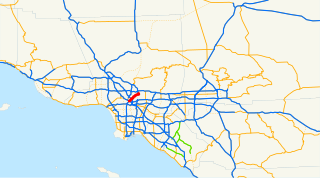
The Arroyo Seco Parkway, also known as the Pasadena Freeway, is one of the oldest freeways built in the United States. It connects Los Angeles with Pasadena alongside the Arroyo Seco seasonal river. It is notable not only for being an early freeway, mostly opened in 1940, but for representing the transitional phase between early parkways and modern freeways. It conformed to modern standards when it was built, but is now regarded as a narrow, outdated roadway. A 1953 extension brought the south end to the Four Level Interchange in downtown Los Angeles and a connection with the rest of the freeway system.
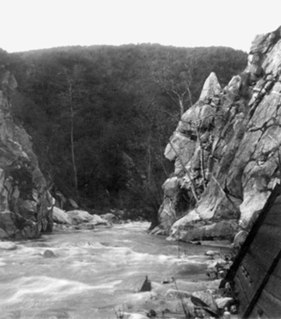
The Arroyo Seco, meaning "dry stream" in Spanish, is a 24.9-mile-long (40.1 km) seasonal river, canyon, watershed, and cultural area in Los Angeles County, California. The area was explored by Gaspar de Portolà who named the stream Arroyo Seco as this canyon had the least water of any he had seen. During this exploration he met the Chief Hahamog-na (Hahamonga) of the Tongva Indians.

Ernest Allan Batchelder was an American artist and educator who made Southern California his home in the early 20th century. He created art tiles and was a leader in the American Arts and Crafts Movement.
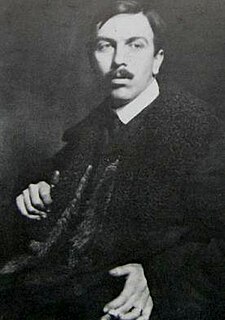
Alson Skinner Clark was an American Impressionist painter best remembered for his landscapes. He was also a photographer, plein aire painter, art educator and muralist.

Marion Kavanaugh Wachtel was an American plein air painter in watercolors and oils. She lived and worked with her artist husband Elmer Wachtel in the Arroyo Seco near Pasadena, California, in the early 20th century.
Paul Grimm was an artist born to German parents in South Africa in 1891. As a small child, he moved with his parents to the United States. He reportedly was seen as having artistic talent as a child and, as an adult, attended a university-level art school in New York. Between 1910 and 1920, he reportedly went to South America for a few years before returning stateside and settling in southern California.

Franz Albert Bischoff was an American artist known primarily for his China painting, floral paintings and California landscapes. He was born in Steinschönau, Austria. He immigrated to the United States as a teenager where he became a naturalized citizen. While in Europe, his early training was focused upon applied design, watercolor and ceramic decorations.
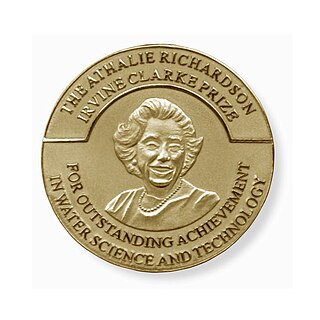
The Athalie Richardson Irvine Clarke Prize, or “Clarke Prize”, is awarded annually by the National Water Research Institute (NWRI) of Fountain Valley, California. It consists of a medallion and $50,000 award for demonstrated excellence in the fields of water science and technology. It recognizes the highest contributions by an individual engaged in the discovery, development, improvement, or understanding of the issues associated with water quality, quantity, technology, or public policy.
Arthur Hill Gilbert was an American Impressionist painter, notable as one of the practitioners of the California-style. Today, he is remembered for his large, colorful canvasas depicting meadows and groves of trees along the state's famed 17 Mile Drive. Gilbert was part of the group of American impressionist artists who lived and painted in the artists' colony scene in California at Carmel and Laguna Beach during the 1920s and 1930s.

Theodore Nikolai Lukits was a Romanian American portrait and landscape painter. His initial fame came from his portraits of glamorous actresses of the silent film era, but since his death, his Asian-inspired works, figures drawn from Hispanic California and pastel landscapes have received greater attention.

The terms California Impressionism and California Plein-Air Painting describe the large movement of 20th century California artists who worked out of doors, directly from nature in California, United States. Their work became popular in the San Francisco Bay Area and Southern California in the first three decades after the turn of the 20th century. Considered to be a regional variation on American Impressionism, the painters of the California Plein-Air School are also described as California Impressionists; the terms are used interchangeably.
Tonal Impressionism was an artistic style of "mood" paintings with simplified compositions, done in a limited range of colors, as with Tonalist works, but using the brighter, more chromatic palette of Impressionism. An exhibition titled "Tonal Impressionism" was curated by the art historian Harry Muir Kurtzworth for the Los Angeles Art Association Gallery at the Los Angeles Central Library in June 1937 with the works of a number of prominent California artists. In recent years, the term has also been used to describe a non-linear approach to painting where the subject is massed in with tonal values without the use of underdrawing.
California Tonalism was art movement that existed in California from circa 1890 to 1920. Tonalist are usually intimate works, painted with a limited palette. Tonalist paintings are softly expressive, suggestive rather than detailed, often depicting the landscape at twilight or evening, when there is an absence of contrast. Tonalist paintings could also be figurative, but in them, the figure was usually out of doors or in an interior in a low-key setting with little detail.
Athalie Anita Irvine, known as Joan Irvine Smith, was an American philanthropist, arts patron, horse trainer and heiress to the Irvine family fortune from their California ranch.

George Herms is an American artist best known for creating assemblages out of discarded, often rusty, dirty or broken every-day objects, and juxtaposing those objects so as to infuse them with poetry, humor and meaning. He is also known for his works on paper, including works with ink, collage, drawing, paint and poetry. The prolific Herms has also created theater pieces, about which he has said, "I treat it as a Joseph Cornell box big enough that you can walk around in. It's just a continuation of my sculpture, one year at a time." Legendary curator Walter Hopps, who met Herms in 1956, "placed Herms on a dazzling continuum of assemblage artists that includes Pablo Picasso, Kurt Schwitters, Marcel Duchamp, and Joseph Cornell, as well as California luminaries Wallace Berman and Edward Kienholz." Often called a member of the West Coast Beat movement, Herms said that Wallace Berman taught him that "any object, even a mundane cast-off, could be of great interest if contextualized properly." "That’s my whole thing," Herms says. "I turn shit into gold. I just really want to see something I've never seen before." George Herms lives and works in Los Angeles.
The Arroyo Seco region has been home and inspiration to artists from Los Angeles' boom years of the 1880s to present day. This region of Northeast Los Angeles that borders the Arroyo Seco and the Los Angeles River encompasses Pasadena, Altadena, Highland Park, Garvanza, Mount Washington, and El Sereno. Historian Kevin Starr defines Arroyo Culture as "a collective designation now given to a loosely defined, scattered movement, many of whose protagonists lived, like Charles Fletcher Lummis at El Alisal, along the Arroyo Seco.

Thomas Lorraine Hunt was a Canadian-American landscape painter of the 1920s and 30s, known especially for his dramatic use of color. His paintings are considered a transition from impressionism to modernism. His primary subjects were boats and harbors in which the colors and shapes on the canvas took precedence over the exactness of the objects. Hunt was active among the Southern California group of Impressionist plein air painters and a founding member of the Laguna Art Museum.
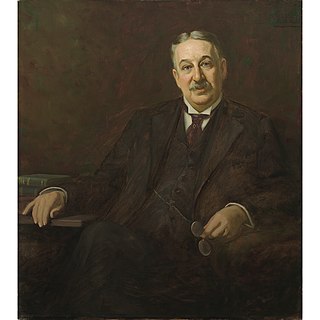
Jean Mannheim was a German-born American artist and educator, known for his California Impressionist paintings. He was active in Decatur, Illinois and Pasadena, California.

Channel "Chan" Pickering Townsley or C.P. Townsley (1867–1921) was an American painter, art administrator, and educator. The subject and genre of his California Impressionist paintings were landscapes, portraits and still lives. He served as a director of Otis Art Institute (1914–1921) and Stickney Memorial Art School (c.1912–1918).














